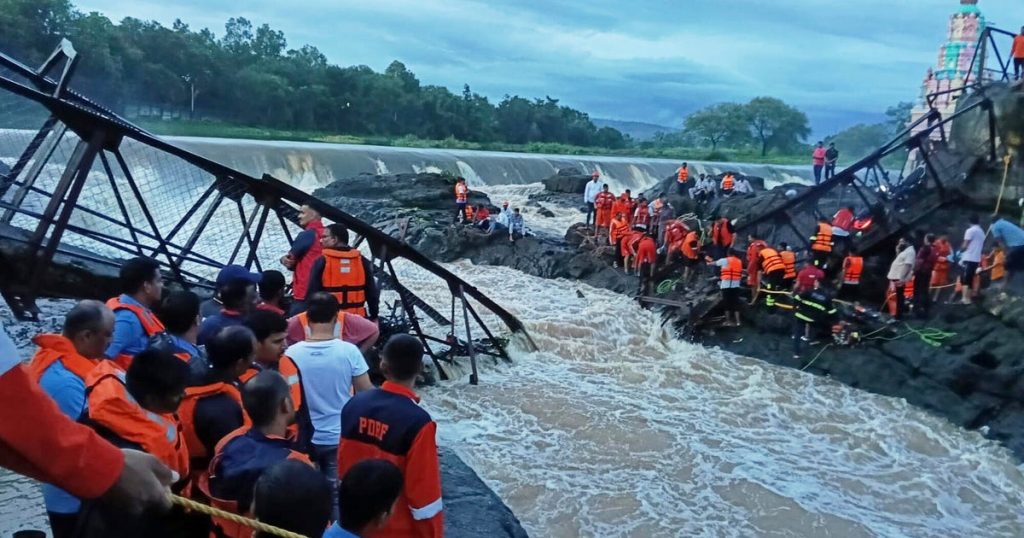A tragic incident unfolded in India’s western Maharashtra state on Sunday when an iron bridge collapsed at a popular tourist spot, resulting in the deaths of at least two individuals and injuring 32 others. The Maharashtra Chief Minister, Devendra Fadnavis, confirmed that several of the injured are in critical condition. Local reports indicate that numerous tourists were on the bridge when it gave way, with many falling into the turbulent waters below.
The incident occurred in the Kundamala area of Pune district, which has recently experienced heavy rainfall. Prime Minister Narendra Modi has expressed his condolences and pledged support to the state government in responding to the disaster. As search and rescue operations continue, concerns regarding India’s infrastructure and safety are once again coming to the forefront.
| Article Subheadings |
|---|
| 1) Overview of the Bridge Collapse Incident |
| 2) Response from State and National Leaders |
| 3) Search and Rescue Operations Underway |
| 4) Historical Context of Infrastructure Issues |
| 5) Community Impact and Future Measures |
Overview of the Bridge Collapse Incident
On Sunday, the bridge collapse occurred in the Kundamala section of Pune district, which is predominantly known for its scenic beauty and serves as a popular picnic destination. Local officials reported that the bridge gave way while numerous tourists were traversing it, resulting in the tragic fall of many individuals into the river beneath. While the exact number of victims is still being confirmed, initial accounts suggest that at least two people lost their lives and 32 others sustained injuries, some of whom are in critical condition. The sudden collapse in an otherwise serene environment poses questions about the stability and safety of such structures.
Response from State and National Leaders
In the wake of this tragedy, Devendra Fadnavis, the Chief Minister of Maharashtra, expressed profound sadness regarding the incident via social media. He stated his condolences to the bereaved families and highlighted the critical condition of several individuals hospitalized for their injuries. Following this event, Prime Minister Narendra Modi reached out to the Chief Minister to convey his deep grief and assured that the federal government would provide any assistance required to the state. This incident highlights not just a local tragedy but also a significant national concern as leaders deliberate on how to address the underlying safety issues in India’s infrastructure.
Search and Rescue Operations Underway
Search and rescue operations commenced shortly after the collapse, led by teams from the National Disaster Response Force (NDRF). Reports indicate that at least six individuals have been rescued thus far. The operations have been complicated by the river’s swift current, which has made it challenging for rescue workers to navigate. Officials are actively reviewing access points to the river, and emergency services remain on high alert in case additional victims are located. The swift response of rescue teams underscores the urgency of the situation and the need for efficient coordination among various emergency units.
Historical Context of Infrastructure Issues
The bridge collapse highlights a growing concern about the safety and maintenance of infrastructure in India. This is not an isolated event; infrastructure failures have led to catastrophic accidents across the country. Just last year, a century-old cable suspension bridge in Gujarat dramatically failed, resulting in the deaths of at least 132 people and raising alarms regarding the condition of older structures. Local and state authorities have repeatedly faced criticism for lax regulations and poor maintenance practices, prompting calls for comprehensive infrastructure reform and rigorous safety audits.
Community Impact and Future Measures
The repercussions of this incident extend beyond the immediate tragedy. The affected families are left to grapple with their losses, while local businesses and the tourism industry are likely to experience a downturn due to heightened safety concerns. Community members are urging authorities to conduct thorough investigations into the collapse and prioritize the maintenance of existing structures. Furthermore, there have been calls for increased funding and resources to ensure that a communication plan is in place, educating the public about safety measures when visiting such popular sites.
| No. | Key Points |
|---|---|
| 1 | Two people died and 32 others were injured in the bridge collapse in Maharashtra. |
| 2 | Search and rescue operations are ongoing, with six individuals already rescued. |
| 3 | Prime Minister Modi has expressed condolences and pledged federal support. |
| 4 | The incident raises concerns about infrastructure safety across India. |
| 5 | Local communities are calling for investigations and better safety measures. |
Summary
The recent bridge collapse in Maharashtra has not only claimed lives but has also ignited long-standing discussions about the safety and reliability of India’s infrastructure. The swift actions by both state and national leaders, coupled with ongoing rescue operations, reflect the urgency of the situation. As the community mourns, the call for systemic reforms becomes increasingly apparent, urging officials to take decisive steps to enhance infrastructure safety for future generations.
Frequently Asked Questions
Question: What caused the bridge to collapse?
While the exact cause is still under investigation, heavy rainfall in the days leading up to the incident may have contributed to the river’s swelling and the structural failure of the bridge.
Question: What authorities are involved in the rescue operations?
The National Disaster Response Force (NDRF) is leading the rescue efforts, alongside local police and emergency services, to locate and assist victims of the collapse.
Question: How can the community ensure better infrastructure safety in the future?
Community members can advocate for regular inspections and maintenance of public structures, urging local and state governments to prioritize infrastructure funding and safety awareness campaigns.


